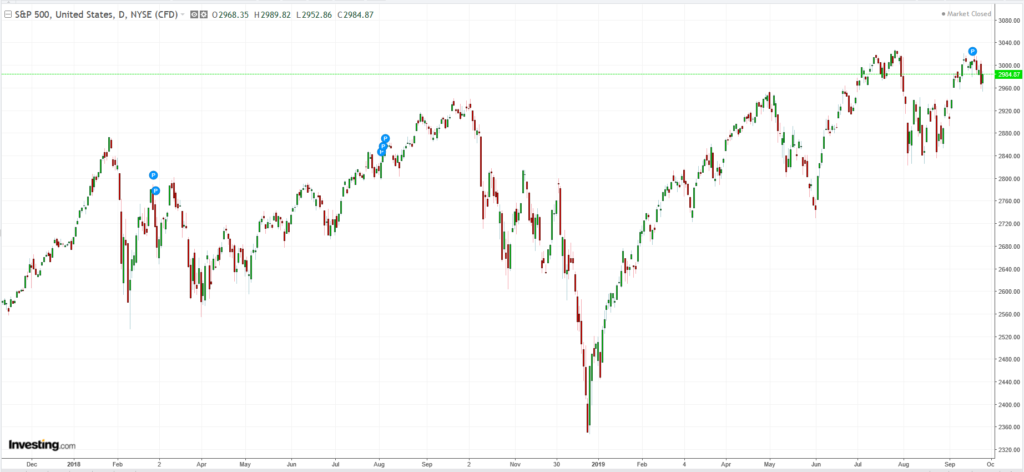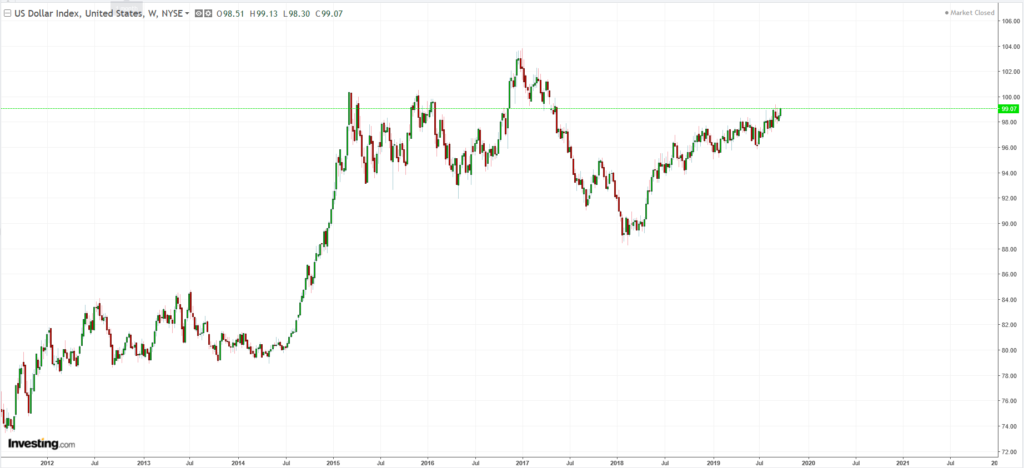The US Dollar has been the world’s reserve currency for the better part of a century and during this time it has seen its ups and downs. Since the second half of 2014, the USD has experienced a bull market, with a brief respite during 2017. But the tides may soon shift and we could possibly see a bear market in the USD over the medium to longer term.
There are many fundamentals and other factors involved. In fact, being the world’s reserve currency, there are so many factors at play that it’s virtually impossible to make a clear call. However, there are many factors that could possibly currently be indicating that a bear market in the USD may be upon us.
Here are 7 reasons why:
US Budget and Trade Deficits
Despite macho rhetoric and posturing, the Trump Administration in the US has still failed to reign in that country’s massive budget and trade deficits. These factors invariably have a negative effect on the value of a nation’s currency. The value of the US Dollar Index (which measures the value of the US Dollar against a basket of other currencies) is affected by changes in the balance of trade.
Furthermore, the US’s trade deficit clearly indicates that more foreign goods are in demand than domestic, which leads to net outflows. Continuing this pattern over a sustained period of time will lead to devaluation of the dollar.
Of course, the USD has managed to evade any major repercussions as a result of its status as the world’s reserve currency. Unlike other countries, the US buys foreign goods in its own currency and this status quo tends to maintain Dollar stability along with demand for US Dollars worldwide for trade.
Reduced Reliance on the Dollar
With the rise of China, India and Russia and the emboldening of various other countries such as Brazil, Iran and some African countries, there is now a growing trend away from using USD Dollars to settle global trade payments. Some countries are happy to settle in other currencies such as the Renminbi or even gold or other commodities.
Alternative payment settlement mechanisms such as cryptocurrencies and blockchain are also playing a role in providing methods for settling international payments that bypass the US dollar, such as RippleNet which is used by Euro Exim Bank. Again, these are still in their infancy but the potential is massive. ,
While this is in no way a major trend yet, it is certainly a growing one. And as the demand for USD reduces worldwide, if it does at all, we could see a significant reduction in its value against other assets.
A Possible Bear Market for US Stocks
US Stocks have had an absolutely fantastic run since the aftermath of the global financial crisis in 2008. However, technical and even fundamental indications suggest that the market is running out of steam.
A look at the S&P 500 index for over the last few years clearly shows that the market is now finding it increasingly difficult to make new highs.

A bear market in US Stocks could see massive outflows of US Dollars from US markets and into other markets worldwide, particularly emerging markets, which will see further pressure on the value of the USD as a result.
Fed Loosening
The US Federal Reserve appears to be commencing a loosening cycle with rate cuts having already been made this year, illustrated by the chart below:

Furthermore, bond markets aren’t expecting any further rate hikes in 2019 or 2020, while cuts are not off the cards. This is another factor that could contribute towards the weakening of the Dollar.
Military Action
War or even skirmishes breaking out between the US and Iran or the US and China could have a devastating effect on the value of the Dollar, again because of investor sentiment and the prospect of more government expenditure and increased deficits.
Gold is Bullish
Gold appears to be entering a long-term bull market. Read our in-depth article about this here. <Link to Article>
Gold and the USD are historically inversely correlated. Along with this, if US stocks go into a bear market or the US economy goes into recession altogether, gold will see vast inflows and this has the potential to further weaken the Dollar.
USD Index at Technically Crucial Level
The US Dollar Index is approaching a significant area of price resistance, which it failed to break through in 2017. Therefore, the probabilities at this moment are in favour of a reversal at this level, which coincides with all these other factors.

Other Factors
There are many other factors at play and there is no concrete way to reliably anticipate a bear, bull or neutral USD. Oil plays a role, as do global trade and capital flows, investor sentiment and numerous other factors.
However, having said all this, it is important to note that the USD goes through cycles and tends to go through bull and bear markets from time to time. And, if we see a new bear market for the USD, it’s probably just the next stage of the cycle. Still, positioning yourself correctly in such an event will give you a strategic advantage.





